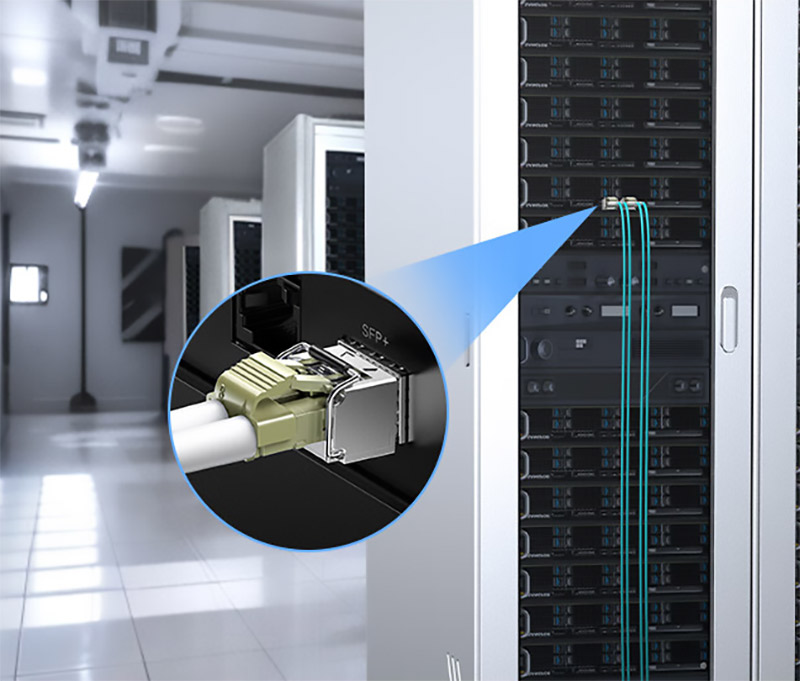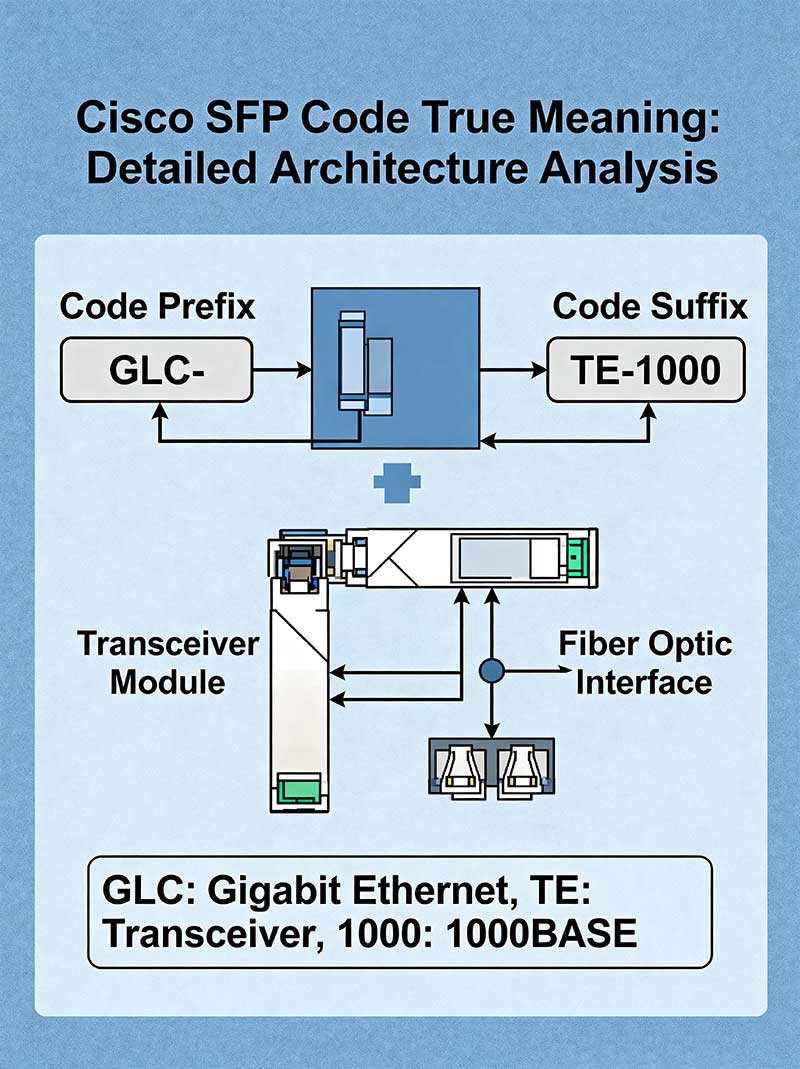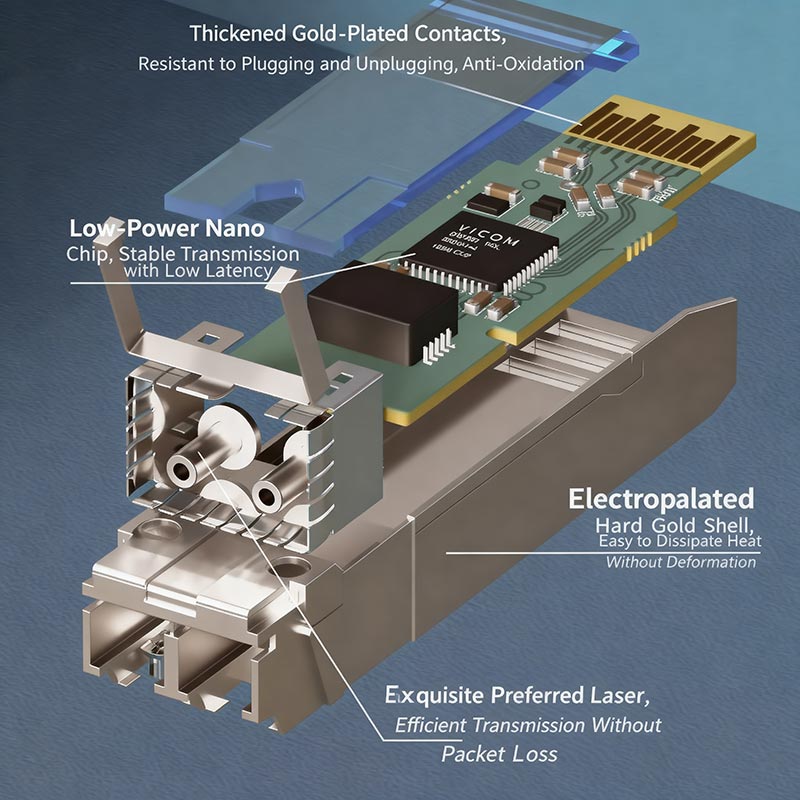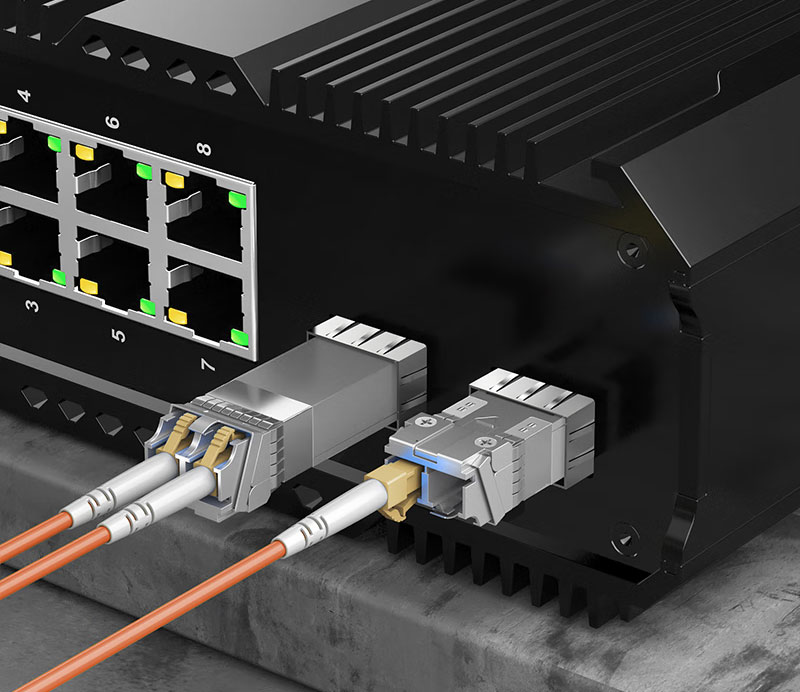How to Decode Cisco SFP Module Model Numbers: Avoiding Wrong Purchases and Reducing Failures

Network administrators have a major challenge determining the right Cisco SFP modules, understanding complex model numbers that directly affect network performance and stability. A network administrator who accidentally interprets one Cisco SFP code incorrectly could create port incompatibility, faulty authentication, or a costly outage that can propagate throughout the entire network and all the components internally connected.
Cisco has a complicated naming system, with multiple variables involved in the name of the Cisco SFP modules: data rates, transmission distance, type of fiber, mixed with various legacy identifiers that have confounded experienced users. The difficulty of understanding Cisco SFP model number patterns often causes users to make procurement mistakes, overpay for modules, or trust products that are counterfeit. The trusted relationship to reliability, which can directly affect your uptime and various components in your network, can be compromised by purchasing unreliable Cisco SFP modules.
The following holistic analysis provides a structured methodology to break down confusing alphanumeric strings into relevant selection factors, authentic verification, and real-life comparison cases that tell a story about the proper code interpretation to avoid disaster related to your network that can result from that code interpretation.
Readers will get access to data-driven, reliable comparisons, step-by-step authentication methods, and ways to prepare for the future of SFP modules in your networks, directed to assure Cisco SFP compatibility in evolving network architectures. Use these proven techniques to remove the guesswork from decision-making regarding your continued infrastructure.
What Cisco SFP Codes Really Mean: A Detailed Architectural Breakdown
Cisco SFP codes serve as exact technical specifications that lay out each working parameter of transceiver modules. Knowing this Cisco SFP code format avoids expensive compatibility mistakes and maximizes network performance in all settings.

Cisco SFP Code True Meaning Detailed Architecture Analysis
Prefix Architecture: Form Factor Definition
The first three letters define key module features. SFP means standard small form-factor pluggable transceivers supporting gigabit speeds, and SFP+ means 10 gigabits. The letters GLC refer to legacy Gigabit Link Card modules from earlier generations of Cisco. As in the example SFP-10G-LR: when reading the model number, the “SFP” prefix immediately denotes the 10-gigabit form factor usability.
Continuing with GLC-SX-MMD, we can see the “GLC” prefix again means this is a legacy gigabit module, and this has some limitations regarding where it can be installed.
Speed Classification: Data Rate Indicators
Number segments in Cisco SFP model numbers indicate specific transmission rates. The “10G” label confirms 10-gigabits-per-second transmission capability. When speed indicators are not displayed, it usually means gigabit capability. In more advanced SFP models, such as the SFP-H10G-ACU10M, the “H10G” describes high-speed 10-gigabit copper direct-attach capability.
These exact speed classifications allow you to prevent bandwidth bottlenecks when upgrading your network.
Media Type: Transmission Medium Definition
Combinations of letters reveal supported transmission media and fiber types. LR (Long Reach) indicates that the fiber type is single-mode and that it has the capability to reach distances of up to 10 kilometers. SR (Short Reach) tells the user that the fiber type is multimode and will reach distances of up to 300 meters. The SX designation in GLC-SX-MMD tells us this is short-wavelength, 850nm using multimode fiber.
ACU, as seen in SFP-H10G-ACU10M, tells us this is a copper direct-attach cable that is compatible for rack-to-rack connections.
Distance Capability: Range Specifications
Suffix codes provide very accurate maximum transmission lengths. The MMD suffixes relate to specific maximum transmission lengths defined by the domain in which the cable will be used. Numerical suffixes like 10M in SFP-H10G-ACU10M define exactly 10 meters of cable length. Extended reach modules will have the ER code under the usual maximum range of around 40 km, which will allow users to connect extended-range interconnects for a metropolitan network.
These distance codes will help provide clarity about the systematic specification for the distance one can go before experiencing over-extension, which will degrade the signal from its intended design distance.
Version Control: Revision Management
Other suffixes apply to product revisions and environmental specifications. Temperature-hardened versions have a specific code indicating operation outside of normal commercial-grade operating ranges.
Sorting Through the Confusion: Understanding Naming Conventions and Legacy Codes
Cisco SFP naming conventions have changed significantly in the last twenty years, which can confuse even the most seasoned network professional. Moving legacy products from one product line to another has caused some overlaps in codes, where part numbers with similar text are used across different form factors or function completely differently.
Legacy Platform Dependencies
Modules used in early Cisco networking products seem obsolete now but are still deployed in legacy installations. The GLC series is an example of this evolution. GLC-SX-MMD modules work the same, identically, as the new SFP-1000BASE-SX modules; however, the mounting is not the same. Also, the legacy product version had firmware limitations specific to the platform.
Catalyst 2960 switches accept certain SFP variants, yet those variants will fail completely in ASR routers while having the same electrical specifications. These Cisco SFP naming conventions are based on internal compatibility rather than standardization found in the industry.
Cross-Platform Code Inconsistencies
Different Cisco product families have inconsistent naming conventions for the same type of functionality. Data center switches use SFP-10G-SR designators. Service provider hardware names the same transceivers ONS-SC+-10G-SR, with the same 10 Gbps short-distance capability. Temperature designs add another level of confusion, as they denote different temperature options with a suffix or variant.
Standard commercial modules do not denote temperature. Industrial modules will denote an extended operating temperature option by adding the -I or -E specification. It is important to note that missing some of these differences can result in field failures in demanding environments.
Firmware-Dependent Variations
A software version will have a massive impact on the module recognition patterns across Cisco devices. IOS 12.x software recognizes legacy Cisco SFP codes differently than IOS-XE systems. This creates an authentication failure when moving from an older IOS device to IOS-XE, or if mixed. Similarly, TAA-compliant variants add complications. For instance, SFP-10G-LR modules sold to government contracts will use SFP-10G-LR++ as a designation.
This variant denotes TAA compliance and not a technical variation. Due to these regulatory variations, procurement teams consistently transferred orders to the wrong variant.
Evolution-Driven Confusion Points
Cisco’s shift from GBIC to SFP resulted in overlapping names wherein similar part numbers can reference completely different technologies. For example, WS-G5484 GBIC modules performed the same functions in the network as GLC-SX-MMD SFPs would. Even though the formats have similar functions, one cannot simply substitute an SFP for a GBIC and vice versa due to physical incompatibility. The designations for copper modules create yet another inconvenience.
For example, SFP-GE-T indicates the functionality of 1000BASE-T copper. The part number, SFP-H10GB-CU1M, indicates a 10-Gig direct-attach copper cable. The numeric suffixes (CU1M, CU3M, CU5M) indicate specific lengths and create challenges during the procurement of these lengths when people assume they all have universal copper compatibility.
Region Market Differences
Internationally, part numbers reflect an alteration that is specific to each country’s regulatory requirements. For instance, the initials -E are appended to part numbers for countries in Europe to denote that they comply with CE regulations. Asia-Pacific modules have the initials -AP to indicate that they meet local certifications for those countries as they relate to damage and repair. In all variations of Cisco platforms, it is up to the network team to ensure Cisco protocols and specifications are followed to confirm that the specific platforms and replacements modules are on their support matrix rather than simply relying on part numbers and designations for the new modules.
How to Select the Right Cisco SFP Module
Selecting the correct Cisco SFP modules involves an objective assessment of four important factors: device compatibility, transmission distance, fiber infrastructure, and environment. Professional network teams, based on experience, will have workflows to minimize guesswork and avoid costly purchasing mistakes.

Device Compatibility Matrix
The device compatibility matrix should be the first step in selecting your SFP module. Identify the exact model number of switches or routers using equipment labels or access from a management interface. Cisco publishes compatibility matrices that define what types of supported transceiver types are supported for each family of equipment. Then, confirm Cisco SFP compatibility by checking the official Cisco Transceiver Tool on the support portal. For an in-depth look at Cisco SFP compatibility and how to use the compatibility matrix effectively, refer to [“Cisco SFP Compatibility: Expert Handbook for Matrix and Failure Prevention“].
Enter equipment model numbers to display lists of approved transceivers with available status. Remember: Catalyst switches will support different ranges of modules than ASR routers or Nexus platforms. You should also cross-reference your particular IOS version against the supported module documentation. If you skip this process, you might end up discovering that your module does not authenticate when installed, or worse, that the installed modules are not supported.
Distance
Distance measures the maximum distance for the endpoint connection, which is also known as the transmission distance or connection distance. You may already have distance defined on a network topology diagram. Short-reach (SR) modules will generally support distances up to 300 meters using multimode fiber. Long-reach (LR) modules will support up to 10 kilometers for either single-mode or multimode fiber infrastructures.
You will have to pay attention to the application for extended-reach modules to understand if ER (Extended Reach) or ZR (Ultra Long Reach) modules are being specified for 40+ kilometers. These types of modules will have distinctive wavelength characteristics. Direct-attach copper cables will provide a lower-cost option for short-distance (<10m or cost) connection applications, particularly closer to the rack. Distance is often influenced by the budget; often the cost of a copper direct-attach cable will be much lower than the optical transceiver for short-distance interconnections between racks in the data center.
Fiber Infrastructure Matching
Method of Determining Fiber Types Already Installed (Documentation or Test) Single-mode fiber cables can cover longer distances than multimode but require specific wavelength compatibility. Typically, wavelengths operate either at 1310nm or 1550nm depending on the application. Multimode fiber installations with multimode optics will typically use 850nm wavelengths for cost-effective short-distance links that are less than 1km in distance.
It is essential to verify fiber core diameters (50/125µm or 62.5/125µm) to ensure enough light power can couple into the fiber to eliminate distortion. Additional factors, such as connector types, need to be compatible on either side (transceivers and fiber optic infrastructure). LC connectors are the most commonly used for SFP-style applications. If it is an older installation with SC and ST connectors, then at times, it may require using an adapter to connect the new optical transceiver in the switches.
Verification of Environmental Specifications
Standard commercial optical modules are rated for operation typically between 0°C to 70°C, functioning in a standard climate-controlled environment. Industrial applications may require specific temperature variants above the standard compact version of -40°C to 85°C operating temperatures to function in harsh environmental conditions. Power consumption becomes very relevant in a higher-density deployment, and heat generation from units may require additional cooling solutions.
In high-density deployments, the power rating for each module should be checked against the rated port capabilities, and thermal shutdown events should be avoided.
Official Verification Process
Go to cisco.com and find the Product Support section to confirm Cisco module compatibility, followed by downloading the current compatibility matrices associated with your platform. Cross-reference the part numbers you see on these approved lists. You may contact the Cisco Technical Assistance Center if you are using multiple vendors in a complex scenario or have questions about a legacy platform.
TAC engineers will have the most current knowledge of a platform’s limitations and whether there are workarounds for your edge case. If you have purchased a module, be sure to register it in Cisco’s warranty portal so your coverage is authenticated. This process can also help verify the authenticity of the SFP model received, while those that are legitimate will receive full support for manufacturer support and replacement in case of failure, according to standard warranty terms.

How to Spot a Fake: Verifying Cisco SFP Authenticity
Counterfeit SFP modules penetrate network infrastructures using clever disguise tactics, causing businesses to incur losses in the billions due to failures and security incidents. Professional-grade fake Cisco SFP modules replicate authentic packaging while minimizing risky technical shortcuts that could affect the stability of the network.
Physical Inspection Methods
Genuine Cisco modules are manufactured to exact tolerances, which counterfeit SFP modules can rarely replicate. Test the metal housing by pressing down until you feel a deformity; genuine modules will not bend, whereas fake alternatives will exhibit noticeable flex from your body weight. The color of the serial number label will provide instant authentication cues. Genuine Cisco serial number labels will be a light yellowish-orange color.
Fake products will show a dark orange color, which differs greatly from an authentic label. Real serial numbers will also be resistant to rubbing attempts, whereas fake labels will likely smear with just light friction. In addition to the color of the serial number label, plastic clips are color-coded, identifying different modules based on color. Each authentic SFP variant will maintain a consistent clip color, which counterfeit products will often misrepresent or exclude.
Validation of Serial Number Format
Cisco uses a standard 11-character serial format (three letters + four numbers + four alphanumeric characters). The first three characters correspond with the manufacturing facilities, followed by the date code, and then the unique identifier. Typically, the counterfeit SFP may use a serial format such as “H11F797″ instead of the proper serial format—”FNS0827A12H”. Always validate your serial number by reviewing the labels on the device, packaging, or the output from the system with the show idprom interface command.
Genuine modules will have identical serial numbers on all documentation, whereas counterfeit modules will have mismatched or no serial numbers on the packaging, with a different code on the module.
Technical Authentication Methods
The use of suspicious modules in your networking equipment is an effective way to monitor each port’s behavior; counterfeit transceivers showcasing poor electrical performance or lack of required authentication protocols often lead to error-disabled states. Run the show inventory raw command to review the output for additional technical details. Compare this output against published official Cisco documentation for any variance in power consumption, wavelength, or manufacturer identification string.
Using legitimate Cisco transceiver modules, the equipment will have the embedded encrypted certificates that counterfeit transceiver modules will not have. The network equipment will authenticate the encrypted certificate when turning on the network equipment and will not allow any unauthorized device in the boot sequence due to its built-in security technology.
An example of extreme failure that can happen is when a financial services company experienced a catastrophic failure of their network after they purchased two hundred counterfeit SFP-10G-LR modules running at a discount of more than 50% from a registered reseller in the area. They used these counterfeit modules for six weeks until they realized that those counterfeit transceivers operated at a pace 38% slower than the specifications and had a power loss of 2.1 dB higher than regular operation for each run. The counterfeit SFP transceiver modules also had serial numbers abbreviated down to window length, starting with “P,” and those SFP transceiver modules did not follow a valid format expected for legitimate Cisco SFP transceivers.
The result was, when their ports were enabled, their error rates jumped by 300% until the module completely shut down within six weeks of installation. The company ended up spending upwards of $780,000 to replace the hardware and deal with downtime and other costs. Preventive measures do exist: verify that the Cisco SFP is legitimate and not counterfeit, for example, by using the Cisco serial number checker from their website before using the SFP in your network equipment. If you are unsure when you buy from a third party, contact the serial number with the Cisco Technical Assistance Center for confirmation.
You should also keep a detailed record of where the product originated by tying the serial number to an authorized distributor. The legitimate distributor will have ways to honor warranties and provide technical support to their customers that counterfeit transceivers will not be able to do.

Case Study and Data Monitoring
A major medical establishment experienced a complete failure of network isolation across three data centers when information technology (IT) was misled by the specifications of an SFP-10G-LR module while performing an infrastructure upgrade over the weekend. Network administrators thought that LR (long range) meant ER (extended range), and therefore deployed 10-kilometer-rated transceivers on 25-kilometer fiber strands.
Failure Cascade Analysis
The optical power levels dropped below the receiver’s sensitivity levels within four hours, indicating a loss of signal. The bit error rate (BER) started to increase from normal rates of 10^-12 to catastrophic levels of 10^-6. This triggered the automated shutdown of every port on 180 interconnected switches. Emergency troubleshooting procedures showed a received power level of -18 dBm, which SFP-10G-LR modules only require -14.4 dBm to operate successfully.
The 3.6 dB delta for exceeding the required distance prevented any data from reaching either facility. SFP-10G-ER modules could have achieved the necessary +4 dBm for transmit power and -18 dBm for receive sensitivity over 25 km. SFP-10G-ER could have been discovered if proper code interpretation had been utilized during the initial planning stages.
Comparative Performance Data
The network monitoring systems collected performance data throughout the 11-hour outage. The SFP-10G-LR modules were at 99.97% reliability at 300 meters to 8 kilometers in distance; and at rates that began to increase exponentially beyond the distance specified.
| Module Type | Max Distance | Failure Rate (0-10km) | Failure Rate (10-25km) |
| SFP-10G-SR | 300m | 0.02% | 100% |
| SFP-10G-LR | 10km | 0.05% | 47% |
| SFP-10G-ER | 40km | 0.08% | 0.12% |
Restoration involved retrofitting 24 technology-specific components with the correct SFP-G-ER versions, at a cost of $38,400 plus $127,000 in operational downtime. The Cisco SFP case study illustrated how the misunderstanding of specifications created an incident, and simple upgrades deteriorated into a critical issue for the business through a series of systematic misinterpretations of code across deployments at an enterprise scale.
The Imminent Future of Cisco SFP Composite Codes: Preparing for Rapid Change
The coding architecture of Cisco transceivers will continue to evolve towards a single codification system that is more predictable, reliable, and clever with regard to artificial intelligence and automation. Smart diagnostic modules will eventually introduce artificial intelligence and diagnostic features directly into the codification of the product, which is an established part number and part number system. The module will soon enable predictive maintenance directly with the telemetry built into the code.
Patterns of Coding from the IoT and AI Aspect
Cisco will eventually update the coding systems to include environmental suffixes across each product line in order to eliminate the current platform-specific differences. The system will also specify temperature suffixes precisely and define the operational range instead of a more commercial or industrial classification. IoT-enabled prefixes will include new mock prefix numbers to identify that the module has analytics or analytics built into it. The technology and advanced transceivers will have the ability to collect and monitor performance metrics and report a performance trend prior to failure.
Strategies for Acting in an Adaptive Proactive Manner
Network planners should set up a systematic way to monitor Cisco product bulletins as they are released, through automated RSS feeds and vendor notifications. In many cases, documentation changes will occur and improve existing technical references 6-12 months before product changes are even publicly released. It would also make sense to maintain existing subscriptions to Cisco’s technical documentation portal, for additional access to the fundamentals of coding specifications, and to monitor updates to the specifications and supporting documents. Collaborate, as necessary, with your Cisco account teams, who can provide awareness and briefings on the imminent future Cisco trends that will affect the planning decisions for infrastructure, as it relates to long-term decisions.
Invest now, yes, invest in your organization to train your technical teams to fully understand the evolving nomenclature before they start the deployment of a new generation of network products. In fact, Cisco’s official certification tracks have taken and will take every opportunity to soon add new coding standards developing in the requirements and course updates in order to help organizations maintain and require staff competencies for the organization through the transition to new systems. Feel free to attend Cisco Live events when updates are required, and meet with the Cisco engineering team that is developing the successor coding and transceiver products or advanced next-generation technology to support vendor compatibility decision-making. Meeting with the engineering team provides great insights into Cisco’s patterns of code evolution as it will relate to late-stage procurement strategies and future installation compatibility planning in an enterprise environment.
Conclusion
The ability to properly decipher Cisco SFP codes is the bedrock of network stabilization and managing operational costs. Not discerning these technical codes leads to cascading failures that cost organizations thousands of dollars on emergency replacements with critical downtime for businesses. Funding professional network teams to build code literacy into an organization as a required competency on the same level as routing protocols or security frameworks. Misreading a single character can unexpectedly turn an usually simple update into an operational disaster.
However, a structured decoding methodology will ensure reliable purchasing decisions within a complicated enterprise environment. Organizations that have adopted structured approaches should see a reduction in module failures and save costs by enhancing the accuracy in determining compatibility. Network professionals who demonstrate this knowledge even have a competitive advantage due to more informed infrastructure decision-making and the ability to proactively mitigate risk. Refer to these approaches with each round of procurement to maintain operational excellence while also protecting from network downtime and costly compatibility disasters.
